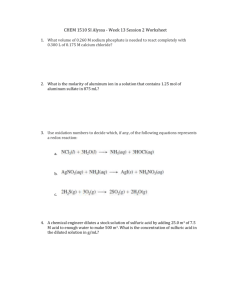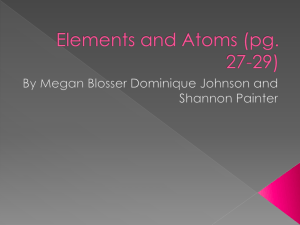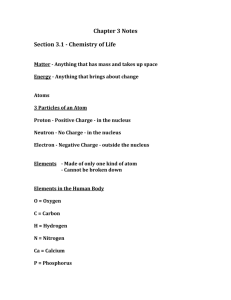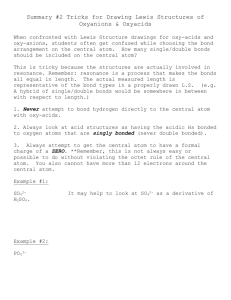Chap 2
advertisement
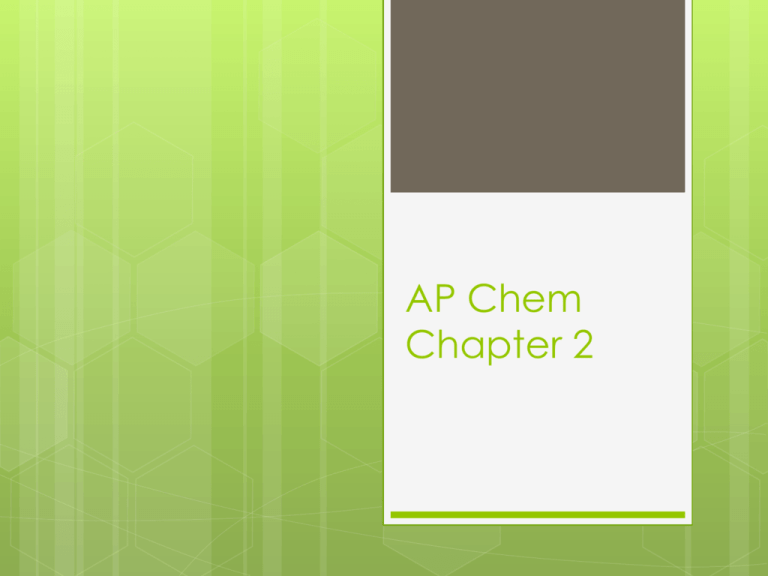
AP Chem Chapter 2 Elements Compounds & Mixtures Elements On the Periodic Table Compounds Ionic (metal bonded to nonmetal) Molecular (2 nonmetals bonded together) Mixtures Homogeneous = Solution = 1 phase Heterogeneous = more than 1 phase What is….? Salt Silver Sand Salt Water Section 2 Law of Conservation of Mass Law of Definite Proportions Law of Multiple Proportions Dalton’s Atomic Theory Very Important. The foundation upon which chemistry is built. Know the 4 postulates Understand how they relate to the Laws. Section 4—Chemical History JJ Thompson Discovered the mass/charge ratio for a particle that was over 1/1000th times smaller than a Hydrogen atom…know to be the least massive atom. He concluded that this particles helped make up the atom. Plum Pudding Model Oil Drop Experiment Used X-rays to knock electrons off of gas molecules. Oil droplets fell through this area and the electrons would stick to the drop. He could measure the mass of the drop by its rate of falling. By turning on an electric field that the drop was falling through, he could make the drop slow down, stop, or even move back up. Oil Drop Experiment In other words, the charged drop was repelled by the electrical charge. Millikan was able to calculate the charge and found that the charge was always a whole number multiple of -1.602 x 10-19C. In relative terms, that charge is -1. Mass/Charge ratio Since we now know the charge, we can multiple the charge times the mass/charge ratio to find the mass of the electron. The mass of the electron is 9.109 x 10-28 g. In relative terms, it has a mass of 0, because protons and neutrons are 1,840 times as massive, and they have a relative mass of 1. Mass of a Proton A proton has a mass of 1.66 x 10-24 g. A neutrons mass is slightly more. 1 amu = approximately the mass of a proton. 1 amu = 1/12 of a C-12 atom Mass of Carbon 1 atom of C-12 has a mass of 12 amu. 1 mole of C-12 has a mass of 12 g. Mass of 1 C atom in grams… 12 amu (1.66 X 10-24 g/ amu) = 1.992 X 10-23 g To find the mass of a mole of C atom, multiply x Avogadro’s number. 1.992 X 10-23 g x 6.02 X 1023 = 12.0 g. Gold Foil Experiment Rutherford discovered the nucleus. Rutherford was investigating the behavior of alpha particles. However, his discovery changed our notions of the structure of the atom. Gold Foil Experiment Rutherford is also credited, by some, with discovering the proton as well. James Chadwich discovered the neutron in 1932. Actually the gold foil experiments were carried out by Geiger, who worked in Rutherford’s lab. Section 5 Mass number Atomic Number Average Atomic Mass Isotopes Calculating Average Atomic Mass Isotope notation A fresh look at atomic theory in light of about 100 years of new discoveries. The Periodic Table Big Fat Review at the table in the back. Section 7: review of bonding Ionic compounds (metal cation/nonmetal anion or polyatomic ion) Criss Cross Simplify if necessary Name by naming ions Metal = same as element Nonmetal = root of word + -ide suffix Polyatomic = name of polyatomic ion Coulomb’s Law Energy = k q1 x q2 / distance k is a constant q are charges of the two ions Distance is the distance between the two nuclei. Increase bond in charges means more energy in the So MgO has more than NaCl Decrease in distance means more energy So NaCl has more than RbI, because the ions are smaller and therefore can get closer to one another. Know Common Charges Monatomic ions (consult the periodic table) Polyatomic ions: pretty much have to memorize (pg 68) Remember that ammonia (NH4+1) is the only polyatomic cation. Remember “ate/ite” rule. Know Common Charges Transition metals have multiple charges (also called oxidation numbers or oxidation states) Cr is +2, +3, or +6. Cr+2 is chromous or chromium (II) Cr+3 is chromic or chromium (III) Cr+6 is chromium (VI) Remember that a polyatomic ion is a group of ions (bonded covalently to each other) and the overall group has an ionic charge. Hydrates Means that water is “tied up” as a part of the crystal structure. CuSO4· 5 H2O is copper (II) sulfate pentahydrate. That is the correct name. If you heat it and drive off the water (which ought to be there), we then say that we have anhydrous copper(II) sulfate. Covalent compounds Two nonmetals bonded together Use prefixes in the name (Table 2.6 on pg 69). NO2 is nitrogen dioxide (no mono prefix is needed if it’s the first element). You name both elements, but add –ide to the root of the second element. N2O is dinitrogen monoxide (if mono is for the second element, you must use it). Acids: Look at the anion the H is bonded to! Remember: H in front of the formula = acid! HCl (bonded to chloride, a monatomic ion) Name is hydrochloric acid Hydro prefix, -ic suffix and add acid HNO2 (bonded Name is nitrous acid Use the root of the anion, add –ous suffix and acid HNO3 to nitrite, so –ite) (bonded to nitrate, so –ate) Name is nitric acid Use the root of the anion, add –ic suffix and acid Simple Organic Compounds: New from Last Year Prefixes Meth = 1 carbon Eth = 2 carbons Prop = 3 But = 4 Pent = 5 Hex = 6 Hept = 7 Oct = 8 Non = 9 Dec = 10 Undec = 11 Dodec = 12 Types of Hydrocarbons Alkanes—all C-C single bonds Ends in -ane Alkenes—contains Ends in -ene Alkynes—contains 1 at least 1 C-C double bond at least 1 C-C triple bond Ends in -yne < 2 < 3 and a < e < y Aromatic—contains at least 1 benzene ring. To Name… Find the longest continuous carbon chain Determine what type of hydrocarbon it is for the suffix. Number the chain so that any substituents (things attached to the chain) have the lowest possible numbers. Keep adding prefixes to the front of the name until everything has been named. Use numbers to specify WHICH carbon the substituent is attached to. Sound complicated?… It’s not. Organic naming is very fun, but it can get pretty hairy. There are millions of different organic compounds, so we had to come up with some way to classify everything. We do this by a concept called “functional group.” A functional group always reacts the same, no matter WHAT ELSE is attached to it. We use R- to represent some “random organic fragment” which is attached to the functional group, but which we really don’t care about right now. Draw the structure 2, 2-dichlorobutane 2, 3-dimethyl propane 2-pentene (2 specifies the position of the double bond) Cyclohexane Mixtures Heterogeneous Homogeneous = solutions Solutions are very important this year ALL over the AP exam Review physical separation techniques, especially distillation and chromatography. TLC = thin layer chromatography GC = gas chromatography HPLC = high pressure liquid chromatography Mass Spectrometry = Mass Spec Used to determine masses of elements or compound very accurately. Used a lot in organic chemistry. Compounds sometimes break into fragments, especially larger organic molecules. Analyzing the possible fragments gives you insight into the overall structure of the molecule. It’s like putting together a puzzle. Mass Spectrometry = Mass Spec Basically the sample is ionized by bombarding it with high energy electrons. An electron is pried off and we now have a cation. Same mass, but it now has charge (remember, an electron has no mass). But the fact that it is charged now is very useful. The charged particles are passed through an electric field (which accelerates them) and a series of slits (which focuses the beam of ions) Although they have the same energy, since they have different masses, they are moving at slightly different speeds. This causes them to begin to separate themselves, by mass. Mass Spectrometry = Mass Spec The charged particles are then passed through a magnetic field which attracts the particles. Lighter particles move closer to the source; heavier particles not so much. They continue to separate by mass. They literally separate into separate streams of ions, each one with a different mass. They then hit a detector which records where they hit and the relative amount that hit each spot. The relative amounts are an indication of % abundance. Where they hit is then compared to known substances with known mass that hits those same spots. Using this information, you can determine the mass of your sample, and the relative abundances, very accurately. Molar Mass Simply add up the masses of each element in the formula, multiplying by any subscripts if necessary. For example Al2(SO4)3 has 2 Aluminum atoms 3 Sulfur atoms 12 Oxygen atoms MM = 342.18 amu or g Amu if we are talking about 1 atom or molecule Grams if we are talking about 1 mole of atoms or molecules. The End See you in Chapter 3 on Weds. Quiz on Weds over Naming and Writing Formulas

